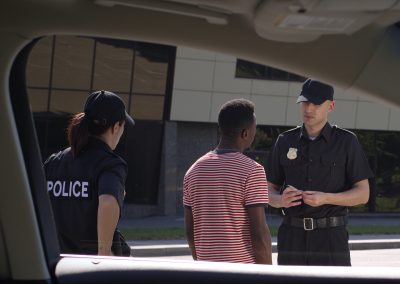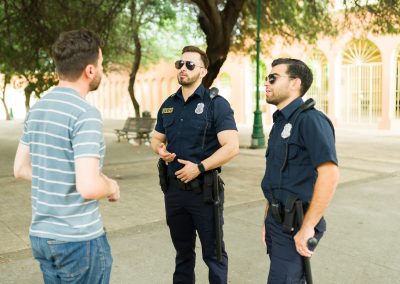This is our final installment of a three-part series on the 21st Century Field Training Officer. (For the other parts, click here and here.) In March of 2016, the National Association of Field Training Officers (NAFTO) had the opportunity to present this information in classroom form to an audience of some of America’s best Law Enforcement instructors at the annual ILEETA conference in Chicago, Ill. The class was well-received and we feel that we passed along some valuable information.
We also put a lot of nerves to rest regarding some of the proliferous opinions and editorials being thrown around hallways, break rooms, and administrative offices inside police departments nationwide.
At first much of what the 21st Century Task Force has recommended seems new and daunting. The truth is—it’s not. Suggestions, theories, concepts, and philosophies inside the Final Report are already in practice within field training programs across the country. They may not be easily recognizable with new names, but, we assure you that you and your agency are likely already satisfying the task force’s suggestions.
If you’re not, here’s what you need to know to get up to speed.
5.13.1 Action Item: The U.S. Department of Justice should support the development of broad Field Training Program standards and training strategies that address changing police culture and organizational procedural justice issues that agencies can adopt and customize to local needs.
A potential model for this is the Police Training Officer program developed by the COPS Office in collaboration with PERF and the Reno (Nev.) Police Department. This problem-based learning strategy used adult learning theory and problem solving tools to encourage new officers to think with a proactive mindset, enabling the identification of and solution to problems within their communities.
Let’s take a closer look at problem-based learning. After reading the manual for the PTO/Reno Model of field training provided by COPS on their website, we did some more research into what it’s all about.
It appears PBL first surfaced within medical schools. That’s not unusual in the training world. Medical schools are often at the forefront of education. Student doctors were challenged to solve a variety of problems regarding patient care. Medical students knew only two things about the problem. First, they knew what their problem was. Second, they knew what their desired outcome needed to be.
The gap between those two points is PBL.
Answers were not directly furnished to the students. Instead, they were encouraged to gather information about both points A and B. They were allowed to collaborate with one another. They were given resources like books, Internet, pertinent data, other students, and previous experience of students, doctors, and medical cases. After gathering all that information, students were asked to put a plan into action for treatment. They then analyzed the results and considered the outcome. If it was a desired outcome, success! If not … back to the drawing board.
Does your field training program teach PBL methods by the name of “OODA Loop” or “Recognition Primed Decision Making”? Does your agency practice “Reality-Based Training” and role-play scenarios? Those are all different approaches to teaching a law enforcement student (trainee) how to problem-solve.
Without a doubt, your agency has developed a community policing policy or strategy. This reinforces the truth that the community is at the heart of law enforcement. A strong bond between the public and their police is essential. In training, be sure to include community impact when it comes to critical decision-making.
As an FTO, when you and your trainee find yourself in the same parking lot for the 100th vehicle burglary, it’s time to deploy long-lasting problem-solving ideas that will have an impact on the community. Maybe even prevent the creation of a 101st report for you and your OIT? The fact that law enforcement and community are tightly intertwined is deeply rooted in the Final Report as well as the PTO field training model.
Do you or your agencies use the San Jose Model, a unique model, or a blended mixture of several FTO models? No worries. Be sure to emphasize community in your training when it comes to PBL and decision-making.
We would argue that the model inside which you train is only as good as the people you employ to operate within it. The field training model is an essential tool for structure, uniformity, tracking, and liability. The FTO is essential to the success of the trainee.
How It Works
When I was supervising the FTO team, one of my trainers found himself responding constantly to an abandoned strip mall in his district. He and his trainees would visit that run-down dump nightly for vagrants, vandalism, and drug activity.
Then the community policing lightbulb went on. My trainer made some phone calls, wrote a few letters, and made some convincing arguments. Now, what used to be vacant buildings with shattered windows is level ground, nicely landscaped, and well lit. This was not only a community policing/problem solving win for the department and city. It was a moment to teach PBL to multiple trainees.
Conclusion
So next time you hear 21st Century Policing in the hallways or board room, don’t shy away from using the comparisons we drew to show that your program was meeting or even exceeding these expectations long before that report was authored.
NAFTO’s annual conference is just around the corner. This year we are in Phoenix, Ariz. The theme for this year’s conference is predominately topics and information from current events in law enforcement. Our goal is to help the FTO gain knowledge and information that will make them a better trainer and better equipped to work within “21st Century” expectations. Sessions on use-of-force considerations will help the patrol officer respond to critical situations. Classes on surviving a hostage situation as a corrections officer will help the officer survive one of the most traumatizing events in detention. This year’s leadership course is specifically designed for trainers in communications. Managing the FTO unit, generational trends, case law studies for trainers, the impact of CIT on law enforcement, and classes on documentation and observation are slated to make your job easier, give you more resources for your problem based learning, and make you a better FTO.
See you there.










0 Comments